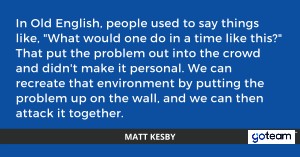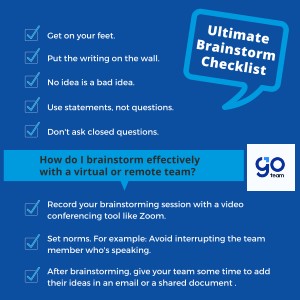An effective brainstorming session is like a house. Without a good framework or structure to build it on, it falls apart.
GoTeam founder Matt Kesby has brainstormed with thousands of leaders, both as an entrepreneur and as execution practice leader for Franklin Covey in Australia and New Zealand.
“If you break the rules for brainstorming that I’m about to share, you’ll take three or four times as long, and not get the result,” he said.
Get on your feet.
First of all, stand up.
Set a time limit, say, seven minutes for a small group that’s brainstorming about one topic. The point of standing up instead of sitting down isn’t to speed the brainstorming session up, although it might have that effect.
In 2014, Stanford University researchers Marily Oppezzo and Daniel L. Schwartz found out that people were more creative (meaning, they came up with ideas that were both novel yet appropriate to the topic) when they brainstormed while walking, rather than sitting around a table.
The researchers used several experiments, including one where participants were asked to imagine, within four minutes, alternative uses for common things such as tires and buttons.
“Walking also exhibited a residual effect on creativity,” Oppezzo and Schwartz wrote in the Journal of Experimental Psychology. “After people walked, their subsequent seated creativity was much higher than those who had not walked.” (They titled their article “Give Your Ideas Some Legs: The Positive Effect of Walking on Creative Thinking.”)
Put the writing on the wall.
Another benefit of not sitting down to brainstorm is that when you direct an idea to another person, it won’t feel like some sort of attack.
Write down every answer offered to the question you’re brainstorming on and then put all the answers up on a wall. You can use sticky notes, flipchart paper, a whiteboard or whatever works for you. The main thing is that every idea goes up and isn’t judged or assessed. That happens in the end.

No idea is a bad idea.
Start with the agreement that no idea, at the start of brainstorming, is a bad idea.
If you’ve got quieter people in the group who are maybe less outgoing—some doves and owls—this is a good way to draw out their ideas before the peacocks and eagles in the room dominate the conversation.
Your chances of an effective brainstorming improve once you understand better how your different team members communicate.
A word on these birds: we’re talking about the Tick Bird Profiles, which describe four personality types and how they differ in their communication styles. We are very happy that GoTeam is now the exclusive licensee in the Philippines for this wonderful personality test.
Use statements, not questions.
The next item is: statements, not questions.
You could, for example, ask “Do you think we should run a pre-payroll process so we can see if it’s accurate before we run it?”
In a brainstorming session, a statement like “Run a pre-payroll process” will lead to more ideas. Prompt your team to then focus on what steps you can take to achieve that goal.
Go over each item on the wall and see if these are actionable tasks that can be converted into procedures. You may need to reword them slightly.
One team member might say, “To run a pre-payroll process well, you need to be friendly with the whole team.” That’s a good idea: payroll can be quite a stressful issue for people. What it needs is a little tweaking so it can be translated into a procedure, something productive your team can do.
How about this? “When sending email about payroll, make sure it has a positive tone to it.” That’s doable with a script or a template, which is the equivalent of a procedure. Done this way, your brainstorming session can lead to specific tasks that can then be executed on and delegated.
Don’t ask closed questions.
When preparing for a brainstorm session, remind your facilitator to avoid closed questions.
“What else?” tends to invite more responses. In contrast, “Is there anything else?” tends to close the discussion.
Also: discourage side conversations. If you’re facilitating and you see two or more people start to have a bit of a side conversation, call a timeout and bring them back into the group’s discussion. This happens all the time and derails brainstorming.
Have your timekeeper remind the group of how much time is left. That’ll keep the energy up!
Using these rules, you’ll achieve the same amount in 7 to 11 minutes brainstorming that you would if you sat around a table for two hours.

How do I brainstorm effectively with a VA?
These rules can all be made to work when you brainstorm with a remote team, such as your virtual assistants in the Philippines—with some tweaks to compensate for the distance and the lack of cues such as body language.
Have someone on your team record your brainstorming session, preferably with a video conferencing tool like Zoom. Recording the session gives your VA something to refer back to, in case they want to be sure they heard the ideas right and understood them.
(If you’re facilitating, you can also use the recording to observe what worked and what you can do better next time. In a face-to-face session, it’s a lot easier to “read” the room because people’s responses are easily visible. That’s more challenging to do if you’re brainstorming via a video conference.)
Avoid interrupting the team member who’s speaking. This is one of the most helpful norms you can set for brainstorming with a remote or distributed team. Agree to speak to the point and commit that no one will interrupt any team member for as long as they’re within the timetable you’ve agreed on. (For example: you can agree that each speaker should do their best to say what they need to say in 2 minutes for each turn.)
After the session, give your team reasonable time to share their ideas via email or a shared document. This will encourage your more introverted team members who may not be comfortable speaking up, yet still have valuable ideas to contribute.
What else? If you’ve brainstormed with a remote team before, what helped? We’d love to hear and learn from your ideas.
Reach out to us at sales@go.team to find out more about starting or expanding your team in your very own global office.
We are GoTeam. Home of Your Global Office.
About GoTeam (formerly Go Virtual Assistants)
GoTeam, formerly GO Virtual Assistants (GO-VA) Inc. is a registered Australian-Filipino owned company growing in the heart of Cebu City, as well as a growing number of key cities in the Philippines.
Our HQ is situated in an IT complex with modern facilities, although since March 2020, more than 70% of our team members have been working from home.
Our enhanced operations and streamlined services provide scalable opportunities that spell sustainability, growth, and success for any business venture. As your global team members, GoTeam’s goal is to create winnable games and strategies across all the work that we do, knowing that your success is our long-term fulfillment.
We help Australian, NZ, US, and UK businesses increase revenue, reduce costs, and scale through outsourced offshoring. This also creates for us the opportunity to be a catalyst for people to exceed.
AU (+61) 2 7227 8809
US (+1) 302 207 2767
PH (+63) 32 238 7448
9th Flr, i1 Bldg, Jose Ma. del Mar St, IT Park,
Cebu City, Philippines 6000
Website: https://go.team
Careers: https://go.team/ph
Email: sales@go.team
Email: careers@go.team







